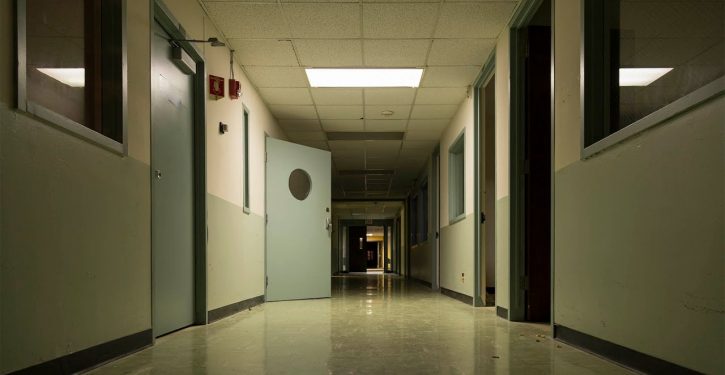
Coronavirus lockdowns include bans on “elective” surgery, even though many hospitals are mostly empty. By banning elective surgery, states not only deprive suffering people of healthcare, but also cause layoffs of healthcare workers. Meanwhile, most hospitals have beds to spare, and enough personal protective equipment (PPE) to handle coronavirus patients. Banning elective surgery doesn’t conserve PPE for coronavirus patients because the personal protective equipment used to treat coronavirus patients is not the same as the equipment used in elective surgery.
Yet, Virginia Governor Ralph Northam recently extended his ban on elective surgeries for yet another week, blocking 15,000 more surgeries. As Kerry Dougherty notes:
Elective surgeries are not cosmetic procedures. They’re often desperately needed surgeries that can be scheduled in advance. That includes some heart procedures, joint replacements, kidney stone removals, gall bladder surgery, eye surgery and a host of other procedures designed to alleviate the pain of thousands. Northam issued his latest edict while ignoring the pleas of patients, doctors and the state hospital association that begged him to allow elective surgeries to resume.
More than 30,000 Virginia healthcare workers have been furloughed or laid off, reports the Virginia Mercury. Many hospitals are “hemorrhaging cash” due to the loss of patients, and some could go bankrupt, according to James A. Bacon, the former publisher of Virginia Business. Moreover, there is no need for the ban on elective surgery:
Will this presidential election be the most important in American history?
Virginia hospitals still have abundant spare capacity to treat COVID-19 patients, and Governor Ralph Northam’s emergency decree against elective surgery continues to drain hospitals of revenue, cost healthcare workers their jobs, and delay many Virginians’ access to healthcare.
The number of COVID-19 patients in hospitals … crept up by six over the day before to 1,405. … Hospitals still have 5,353 beds to spare. Meanwhile the number of patients in ICU units declined by 22, and the number of COVID-19 patients on ventilators nudged up only three. The total of ventilators in use by all patients numbers 629, leaving 2,306 ventilators idle. … Northam’s blanket decree applies uniformly across the state regardless of the prevalence of the virus or the capacity of hospitals to deal with it.
Thus, elective surgery is banned even in regions that have few coronavirus cases, like Virginia’s Roanoke Valley. As Bacon noted on Apr. 25, the entire Roanoke Valley had only 80 coronavirus cases, 6 hospitalizations, and zero deaths — compared with 764 cases, 139 hospitalizations, and 29 deaths in Arlington, Va., which has a similar population. Yet Northam’s order banned elective surgeries in both places, with no exceptions. It did so even though a “policy that might make sense for Arlington is insanely inappropriate for the Roanoke Valley.”
If Northam’s purpose is to bankrupt Roanoke Valley healthcare providers by cutting off their revenue flow, he is making solid progress. If his goal is reducing deaths from the COVID-19 virus, it is difficult to discern how his elective-procedure edict might improve the situation in any way.
Virginia is not alone in having empty hospitals. New York is the state hardest hit by the coronavirus, and over 22,000 New Yorkers have died of the disease. Yet, even it has many hospitals that are growing empty due to New York’s ban on elective surgeries. As the Syracuse Post-Standard notes, “Instead of being swamped with coronavirus patients, Syracuse’s three hospitals are awash with empty beds,” and the three hospitals in that region of New York State “have seen a 41 percent decline in their combined number of patients.”
Bans on elective surgery are not the only counterproductive feature of lockdown orders. Those orders also restrict low-risk activities that are economically important, while often permitting non-essential activities that allow COVID-19 to spread.
Working alone in your office won’t give you coronavirus. Riding a crowded subway can. Yet government lockdowns ban working in many offices where there is plenty of space for social distancing, while letting unnecessary people ride crowded subways.
An MIT study says subways were a “major disseminator” of coronavirus in New York City. But New York City continues to operate a crowded subway. Rather than expanding the number of train cars to prevent crowding, it has cut the number of trains to save money, resulting in passengers being too close to each other. That may be transmitting the virus to essential workers who rely on the subway to get to their jobs.
New York City is aggravating subway crowding through its approach to homelessness. It is allowing homeless people to live on the subway and leave trash and urine in it. According to the New York Post,
The subway has become a filthy, deadly homeless shelter on rails, according to disgusted transit workers who have taken to recording and photographing the horrid conditions.
One video shot earlier this month shows cars of homeless men and women stretched out and slumbering away on an E train. In another filmed Thursday, a man puffs on a cigarette while standing on an E car. A homeless woman was photographed sitting on a 2 train mid-afternoon Wednesday next to an overflowing grocery cart and plastic bags.
And in one video, a man uses the space between the cars on a 2 train as a toilet while stopped in a Brooklyn station.
Meanwhile, New York’s governor closed all “non-essential” businesses on March 20, even if employees could travel to work alone by car and work alone in their office, or deal with customers or co-workers while maintaining a safe distance. This was not long after New York City officials encouraged people to “take the subway” for social and cultural activities not essential to the economy.
Avoiding mass gatherings saves lives during a pandemic. Shutting down most economic activity — and non-emergency healthcare — doesn’t.
There is no evidence that such overzealous lockdowns save lives. As Lyman Stone of the American Enterprise Institute explains, “many policies do provide public-health benefits,” such as quarantining people with coronavirus; wearing masks; temporarily closing schools; banning “large assemblies”; and restricting “long-distance travel.” But “ordering people to cower in their homes” and “ordering small businesses to close up shop regardless of their hygienic procedures simply has no demonstrated effectiveness” in preventing the spread of disease.
So states should mandate social distancing — not shut down clinics for elective surgery, or close businesses that don’t attract crowds.




